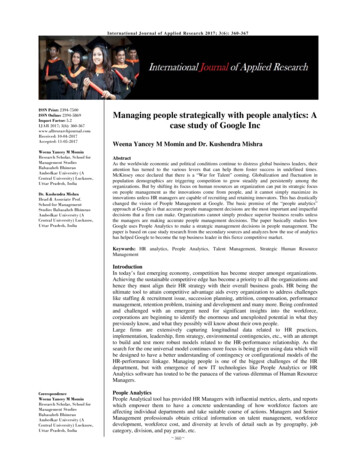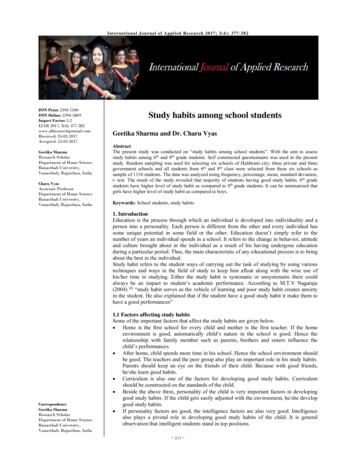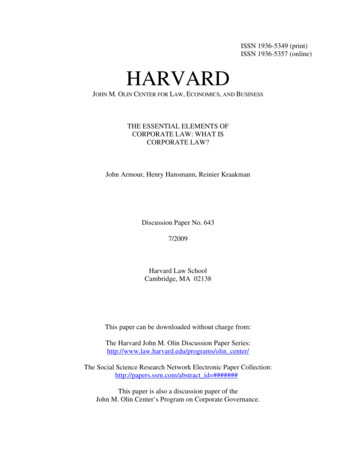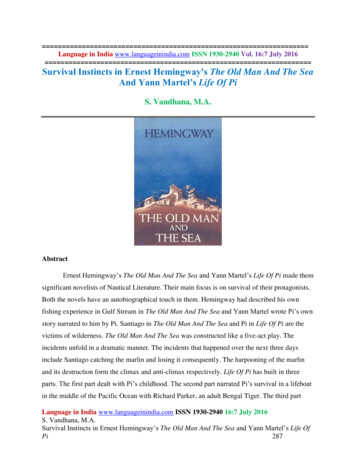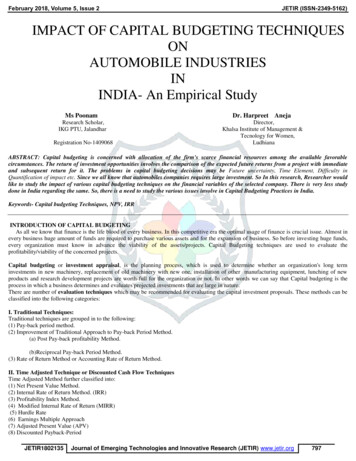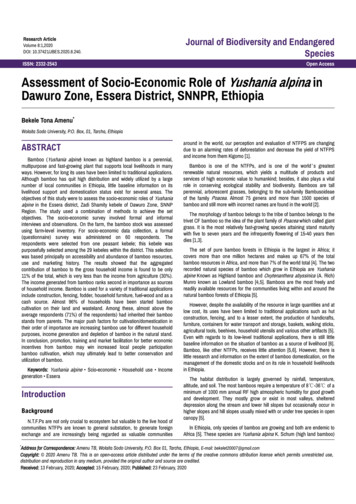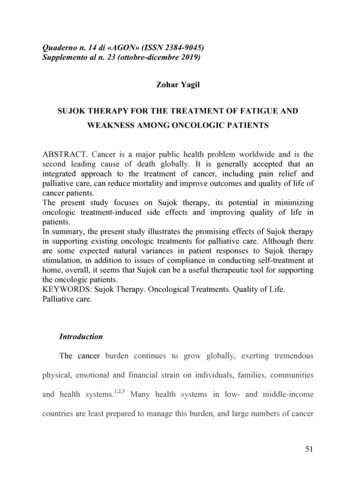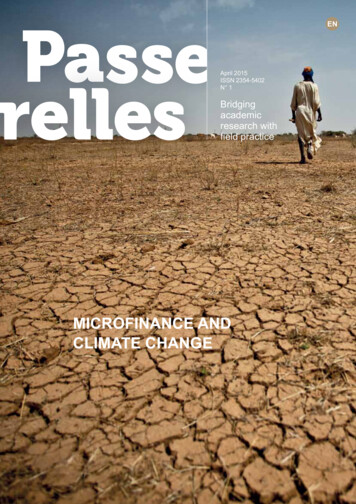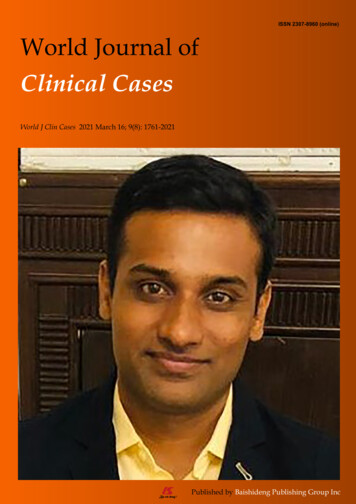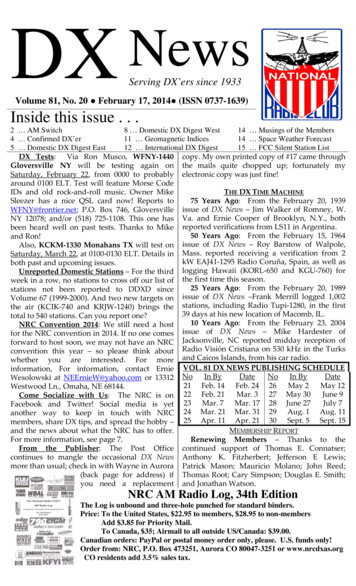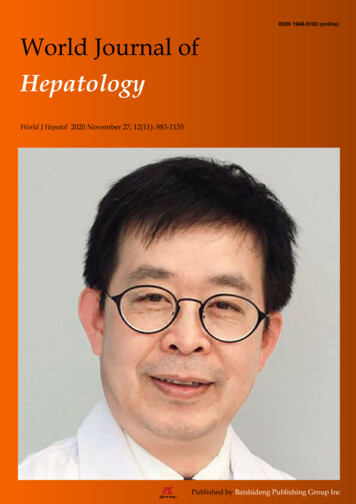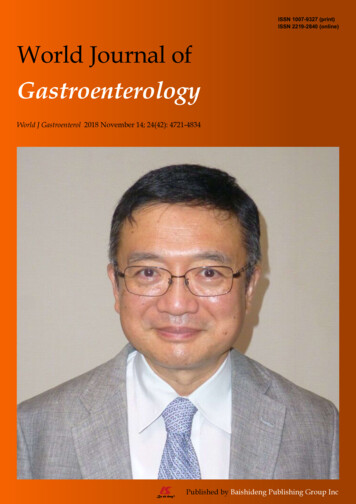
Transcription
ISSN 1007-9327 (print)ISSN 2219-2840 (online)World Journal ofGastroenterologyWorld J Gastroenterol 2018 November 14; 24(42): 4721-4834Published by Baishideng Publishing Group Inc
SContentsWeekly Volume 24 Number 42 November 14, 2018EDITORIAL4721Increased susceptibility of aging gastric mucosa to injury and delayed healing: Clinical implicationsTarnawski AS, Ahluwalia AREVIEW4728Liver as a target of human immunodeficiency virus infectionGanesan M, Poluektova LY, Kharbanda KK, Osna NAMINIREVIEWS4738CXC family of chemokines as prognostic or predictive biomarkers and possible drug targets in colorectal cancerCabrero-de las Heras S, Martínez-Balibrea E4750Gut microbiota in common elderly diseases affecting activities of daily livingShimizu YORIGINAL ARTICLEBasic Study4759Yiguanjian decoction enhances fetal liver stem/progenitor cell-mediated repair of liver cirrhosis throughregulation of macrophage activation stateXu Y, Fan WW, Xu W, Jiang SL, Chen GF, Liu C, Chen JM, Zhang H, Liu P, Mu YP4773Ubiquitin-like modifier activating enzyme 2 promotes cell migration and invasion through Wnt/β-cateninsignaling in gastric cancerLi J, Sun X, He P, Liu WQ, Zou YB, Wang Q, Meng XWCase Control Study4787Mode of delivery by an ulcerative colitis mother in a case of twins: Immunological differences in cord bloodand placentaDunsmore G, Koleva P, Sutton RT, Ambrosio L, Huang V, Elahi SRetrospective Cohort Study4798Increased end-stage renal disease risk in patients with inflammatory bowel disease: A nationwidepopulation-based studyPark S, Chun J, Han KD, Soh H, Choi K, Kim JH, Lee J, Lee C, Im JP, Kim JSRetrospective Study4809Prediction of colorectal tumor grade and invasion depth through narrow-band imaging scoringMaeyama Y, Mitsuyama K, Noda T, Nagata S, Nagata T, Yoshioka S, Yoshida H, Mukasa M, Sumie H, Kawano H, Akiba J,Araki Y, Kakuma T, Tsuruta O, Torimura TSYSTEMATIC REVIEWS4821Burden and outcomes for complex perianal fistulas in Crohn’s disease: Systematic reviewPanes J, Reinisch W, Rupniewska E, Khan S, Forns J, Khalid JM, Bojic D, Patel HWJG www.wjgnet.com November 14, 2018 Volume 24 Issue 42
World Journal of GastroenterologyContentsVolume 24 Number 42 November 14, 2018ABOUT COVEREditorial board member of World Journal of Gastroenterology , Kazuaki Inoue,MD, PhD, Associate Professor, Department of Internal Medicine, Division ofGastroenterology, Showa University Fujigaoka Hospital, Yokohama 227-8501,JapanAIMS AND SCOPEWorld Journal of Gastroenterology (World J Gastroenterol, WJG, print ISSN 1007-9327, onlineISSN 2219-2840, DOI: 10.3748) is a peer-reviewed open access journal. WJG was established on October 1, 1995. It is published weekly on the 7th, 14th, 21st, and 28th each month.The WJG Editorial Board consists of 642 experts in gastroenterology and hepatology from59 countries.The primary task of WJG is to rapidly publish high-quality original articles, reviews,and commentaries in the fields of gastroenterology, hepatology, gastrointestinal endoscopy, gastrointestinal surgery, hepatobiliary surgery, gastrointestinal oncology, gastrointestinal radiation oncology, gastrointestinal imaging, gastrointestinal interventional therapy, gastrointestinal infectious diseases, gastrointestinal pharmacology, gastrointestinalpathophysiology, gastrointestinal pathology, evidence-based medicine in gastroenterology, pancreatology, gastrointestinal laboratory medicine, gastrointestinal molecular biology, gastrointestinal immunology, gastrointestinal microbiology, gastrointestinal genetics,gastrointestinal translational medicine, gastrointestinal diagnostics, and gastrointestinaltherapeutics. WJG is dedicated to become an influential and prestigious journal in gastroenterology and hepatology, to promote the development of above disciplines, and toimprove the diagnostic and therapeutic skill and expertise of clinicians.INDEXING/ABSTRACTINGWorld Journal of Gastroenterology (WJG) is now indexed in Current Contents /Clinical Medicine,Science Citation Index Expanded (also known as SciSearch ), Journal Citation Reports , IndexMedicus, MEDLINE, PubMed, PubMed Central and Directory of Open Access Journals. The2018 edition of Journal Citation Reports cites the 2017 impact factor for WJG as 3.300 (5-yearimpact factor: 3.387), ranking WJG as 35th among 80 journals in gastroenterology and hepatology (quartile in category Q2).EDITORS FORTHIS ISSUEResponsible Assistant Editor: Xiang LiResponsible Electronic Editor: Yan HuangProofing Editor-in-Chief: Lian-Sheng MaNAME OF JOURNALWorld Journal of GastroenterologyISSNISSN 1007-9327 (print)ISSN 2219-2840 (online)LAUNCH DATEOctober 1, 1995FREQUENCYWeeklyEDITORS-IN-CHIEFAndrzej S Tarnawski, MD, PhD, DSc (Med),Professor of Medicine, Chief Gastroenterology, VALong Beach Health Care System, University of California, Irvine, CA, 5901 E. Seventh Str., Long Beach,CA 90822, United StatesEDITORIAL BOARD MEMBERSAll editorial board members resources online at WJG www.wjgnet.comResponsible Science Editor: Ruo-Yu MaProofing Editorial Office Director: Ze-Mao GongEDITORIAL OFFICEZe-Mao Gong, DirectorWorld Journal of GastroenterologyBaishideng Publishing Group Inc7901 Stoneridge Drive, Suite 501,Pleasanton, CA 94588, USATelephone: 1-925-2238242Fax: 1-925-2238243E-mail: editorialoffice@wjgnet.comHelp Desk: net.comPUBLISHERBaishideng Publishing Group Inc7901 Stoneridge Drive, Suite 501,Pleasanton, CA 94588, USATelephone: 1-925-2238242Fax: 1-925-2238243E-mail: bpgoffice@wjgnet.comHelp Desk: net.comCOPYRIGHT 2018 Baishideng Publishing Group Inc. Articles published by this Open-Access journal are distributed underthe terms of the Creative Commons Attribution Noncommercial License, which permits use, distribution,and reproduction in any medium, provided the originalwork is properly cited, the use is non commercial and isotherwise in compliance with the license.SPECIAL STATEMENTAll articles published in journals owned by the BaishidengPublishing Group (BPG) represent the views and opinions of their authors, and not the views, opinions orpolicies of the BPG, except where otherwise explicitlyindicated.INSTRUCTIONS TO AUTHORSFull instructions are available online at http://www.wjgnet.com/bpg/gerinfo/204ONLINE SUBMISSIONhttp://www.f6publishing.comPUBLICATION DATENovember 14, 2018IINovember 14, 2018 Volume 24 Issue 42
World J Gastroenterol 2018 November 14; 24(42): 4721-4727Submit a Manuscript: http://www.f6publishing.comDOI: 10.3748/wjg.v24.i42.4721ISSN 1007-9327 (print) ISSN 2219-2840 (online)EDITORIALIncreased susceptibility of aging gastric mucosa to injuryand delayed healing: Clinical implicationsAndrzej S Tarnawski, Amrita AhluwaliaAndrzej S Tarnawski, Amrita Ahluwalia, Department ofGastroenterology Research, University of California Irvine andthe Veterans Administration Long Beach Healthcare System, LongBeach, CA 90822, United StatesFirst decision: October 9, 2018Revised: October 12, 2018Accepted: October 21, 2018Article in press: October 21, 2018Published online: November 14, 2018ORCID number: Andrzej S Tarnawski (0000-0002-6813-6698);Amrita Ahluwalia (0000-0002-2064-5725).Author contributions: Tarnawski AS and Ahluwalia A contributedto this paper; Tarnawski AS designed the overall concept andoutline of the manuscript; Ahluwalia A contributed to thediscussion and design of the manuscript; Tarnawski AS andAhluwalia A contributed to the writing, and editing the manuscript,illustrations, and review of literature.AbstractIn this editorial we comment on the article by Fukushi Ket al published in the recent issue of the World Journalof Gastroenterology 2018; 24(34): 3908-3918. We focusspecifically on the mechanisms of the anti-thromboticaction of aspirin, gastric mucosal injury and aging-relatedincreased susceptibility of gastric mucosa to injury. Aspirinis widely used not only for the management of acuteand chronic pain and arthritis, but also importantly forthe primary and secondary prevention of cardiovascularevents such as myocardial infarcts and strokes. Clinicaltrials have consistently shown that antiplatelet therapywith long term, low dose aspirin (LDA) - 75 to 325 mgdaily, dramatically reduces the risk of non-fatal myocardialinfarcts, stroke and mortality in patients with establishedarterial diseases. However, such treatment considerablyincreases the risk of gastrointestinal (GI) ulcerationsand serious bleeding by 2-4 fold, especially in agingindividuals. This risk is further increased in patientsusing LDA together with other antiplatelet agents,other nonsteroidal anti-inflammatory agents (NSAIDs)and/or alcohol, or in patients with Helicobacter pylori(H. pylori ) infection. Previous studies by our group andothers have demonstrated prominent structural andfunctional abnormalities in gastric mucosa of agingindividuals (which we refer to as aging gastric mucosa or“aging gastropathy”) compared to the gastric mucosa ofyounger individuals. Aging gastric mucosa has impairedmucosal defense, increased susceptibility to injury by avariety of noxious agents such as aspirin, other NSAIDsand ethanol, and delayed and impaired healing of injury.The mechanism underlying these abnormalities of aginggastric mucosa include reduced mucosal blood flowSupported by Merit Review Award from the United StatesDepartment of Veterans Affairs Biomedical Laboratory Researchand Development Service, No. I01 BX000626-05A2 to TarnawskiAS.Conflict-of-interest statement: Andrzej S Tarnawski andAmrita Ahluwalia have nothing to disclose.Open-Access: This article is an open-access article which wasselected by an in-house editor and fully peer-reviewed by externalreviewers. It is distributed in accordance with the CreativeCommons Attribution Non Commercial (CC BY-NC 4.0) license,which permits others to distribute, remix, adapt, build upon thiswork non-commercially, and license their derivative works ondifferent terms, provided the original work is properly cited andthe use is non-commercial. See: script source: Invited manuscriptCorrespondence to: Andrzej S Tarnawski, MD, PhD, DSc,FACG, AGAF, Professor, Gastroenterology Research Department,University of California Irvine and the Veterans AdministrationLong Beach Healthcare System, 5901 E. Seventh Street, LongBeach, CA 90822, United States. atarnawski@yahoo.comTelephone: 1-562-8264956Fax: 1-562-8265675Received: August 28, 2018Peer-review started: August 28, 2018WJG www.wjgnet.com4721November 14, 2018 Volume 24 Issue 42
Tarnawski AS et al . Increased susceptibility of aging gastric mucosa to injurycausing hypoxia, upregulation of PTEN, activation of proapoptotic caspase-3 and caspase-9, and reduced survivin(anti-apoptosis protein), importin-α (nuclear transportprotein), vascular endothelial growth factor, and nervegrowth factor. The decision regarding initiation of along-term LDA therapy should be made after a carefulconsideration of both cardiovascular and GI risk factors.The latter include a previous history of GI bleeding and/or ulcers, age 70, male gender, concurrent use of otherNSAIDs, alcohol consumption and H. pylori infection.Furthermore, the incidence of GI ulcers and bleedingcan be reduced in patients on long term LDA treatmentby several measures. Clinicians treating such patientsshould test for and eradicate H. pylori , instruct patientsto avoid alcohol and non-aspirin NSAIDs, includingcyclooxygenase-2-selective NSAIDs, and prescribeproton pump inhibitors in patients on LDA therapy. In thefuture, clinicians may be able to prescribe one of severalpotential new drugs, which include aspirin associatedwith phosphatidylcholine (PL2200), which retains allproperty of aspirin but reduces by approximately 50%LDA-induced GI ulcerations.inhibitor of cyclooxygenase (COX), an enzyme synthe sizing prostaglandins and thromboxanes. The COX-1isoform is expressed constitutively in most tissues. Inthe gastrointestinal (GI) mucosa and kidneys, COX-1plays a critical role in maintaining these tissues’ integrityby generating prostaglandin E2 (PGE2) and prostacyclin[5,6](PGI2) from arachidonic acid . In blood platelets, COX-1generates thromboxane A2 (TXA2), which promotestheir aggregation and thrombi formation. The COX-2isoform is constitutively expressed in brain, kidneys,intestine, and endothelial cells, and is induced in varietyof tissues in response to proinflammatory cytokines and[5,6]growth factors . COX-2 generated prostaglandins playcritical roles in gastric mucosal defense, cytoprotection,[5-7]angiogenesis and ulcer healing . While aspirin inhibitsboth COX-1 and COX-2 isoforms, in low doses itpredominantly inhibits COX-1; while in higher doses italso inhibits COX-2. LDA treatment acetylates COX-1 atserine-529 residue and irreversibly inhibits COX-1 activityin platelets for about 10 d (life time of platelets) resultingin almost complete inhibition of production of TXA2 fromarachidonic acid, and inhibition of platelet aggregation[8,9]and thrombi formation . These actions of aspirin aresummarized in Table 1.Due to the anti-thrombotic and cardioprotectiveeffects, LDA defined as 75 to 325 mg daily, alone orin combination with other antiplatelet agents (e.g.,clopidogrel) became a standard treatment for thesecondary prevention of CVE (MI and stroke). Clinicaltrials consistently showed that antiplatelet therapy withLDA daily dramatically reduces the risk of nonfatal MI,stroke and mortality in patients with established arterial[1-3]diseases . The Second International Study of InfarctSurvival (ISIS-2) showed that a daily 160 mg LDAadministered for 30 d confers significant cardioprotectionthat resulted in a significant reduction of reinfarction and[1]strokes LDA treatment significantly reduces the riskof MI, stroke, and mortality in a wide range of high-risk[2,9]patients . The Antithrombotic Trialist’s Collaborationmeta-analysis of 287 trials that included over 200000patients with high cardiovascular risk, showed that dailyantiplatelet therapy with 75-150 mg LDA significantly[2]reduced the risk of CVE by approximately 32% . Theseand other studies show that aspirin confers significantcardio protection to the majority of patients with coronaryheart disease, ischemic stroke, peripheral arterial disease[1,2]and systemic embolism . Importantly this treatmenthas a simple dosage, low cost, and a good safetyrecord and therefore is widely used world-wide. Thecardioprotective action of aspirin appears to be unique;the other nonselective nonsteroidal anti-inflammatorydrugs (NSAIDs), such as ibuprofen and naproxen, donot significantly impact cardiovascular diseases. Unlikeaspirin, the latter NSAIDs bind only reversibly to COX-1and inhibit platelet function for only brief time. Selec tive COX-2 inhibitors do not inhibit formation TXA2 byplatelets and do not have substantial cardioprotectiveKey words: Aging gastric mucosa; Injury; Low doseaspirin; Platelets; Cyclooxygenase-1; Cyclooxygenase-2;Thromboxane A-2 The Author(s) 2018. Published by Baishideng PublishingGroup Inc. All rights reserved.Core tip: Low dose aspirin is widely used to preventcardiovascular events such as myocardial infarcts andstrokes; however, this therapy significantly increasesthe risk of gastrointestinal injury and induces ulcerationand serious bleeding especially in aging individuals.This risk is further increased in patients using low doseaspirin concurrently with other antiplatelet agents, othernonsteroidal anti-inflammatory agents and/or alcohol, orin patients with Helicobacter pylori infection.Tarnawski AS, Ahluwalia A. Increased susceptibility of aginggastric mucosa to injury and delayed healing: Clinical implications.World J Gastroenterol 2018; 24(42): 4721-4727 Available from:URL: htmDOI: TIONAspirin (acetyl salicylic acid) synthesized in 1897 by FelixHoffman in Bayer Laboratories in Germany, has becomeone of the most successful drugs used initially for thetreatment of acute and chronic pain and arthritis. Morerecently a regular treatment with low dose aspirin (LDA)it is used for a primary and secondary prevention ofcardiovascular events (CVE) such as myocardial infarcts[1-3](MI) and strokes in which it reduces mortality . As[4]demonstrated by Vane et al , aspirin is a non-selectiveWJG www.wjgnet.com4722November 14, 2018 Volume 24 Issue 42
Tarnawski AS et al . Increased susceptibility of aging gastric mucosa to injuryTable 1 Action of Aspirin on platelets and gastrointestinal mucosa and its unique features compared with other nonsteroidal antiinflammatory drugsAspirin is a non-selective inhibitor of cyclooxygenase (COX), an enzyme involved in the synthesis of prostaglandins and thromboxanes (TXA) fromarachidonic acidAspirin inhibits both COX-1 and COX-2 isoforms with a greater inhibition of COX-1 than COX-2 (approximately 100-fold) in low doses COX-1 isoformis expressed constitutively in most tissues: Gastrointestinal mucosa and kidneys and by generating prostaglandin E2 (PGE2) and prostacyclin (PGI2)and plays a critical role in maintaining tissue integrity at basal level COX-1-induced thromboxane A2 (TXA2) generation causes platelet aggregation andthrombi formation and is the basis for cardiovascular eventsCOX-2 isoform is constitutively expressed in some tissues (the brain, kidneys, intestine, and endothelial cells). In other tissues COX2 is induced inresponse to local irritants, proinflammatory cytokines and growth factors.COX2 generated prostaglandins PGE2 and PGI2 play a critical role in gastric mucosal defense in response to injury and promote angiogenesis, ulcerhealing, and (cancer growth)Aspirin–has potent antithrombotic and cardioprotective properties: Irreversibly inactivates platelet COX-1 (vs only temporary inhibition by othernonselective NSAIDs) TXA2 synthesis, platelet aggregation, and thrombi formation which are all basis for cardiovascular events Cardiocerebrovascular eventsIn addition, aspirin may prevent and/or reduce cancer. A recent meta-analysis of 8 trials[38,39] showed that LDA reduces cancer incidence and mortalityAspirin advantage - single daily dose, low cost, good safety profileaction; in fact, some COX-2 selective inhibitors may[10]increase the risk of cardiovascular events .A long-term, LDA treatment is not without risk sinceit can induce gastroduodenal injury, ulcers and severe[11-18]bleeding especially in elderly patients. The mainunderlying mechanism is that aspirin inhibits generationof PGE2 and PGI2 which are critical for mucosa defense,protection and maintenance of gastrointestinal mucosal[7]integrity (Figure 1). In addition, inhibition of TXA2dependent platelet function by aspirin prevents thrombiformation in injured vessels and causes uncontrolledbleeding. Cryer and Feldman showed that long-termLDA treatment in healthy subjects significantly reducesgastric mucosal prostaglandin levels by approximately60% and causes gastric and duodenal injury in some[19]patients . The risk of development of peptic ulcers inaspirin (or non-aspirin NSAIDs) users was examined inapproximately 460000 patients (between 1995 and 1999)and shown to be increased to 2.9 for aspirin and 4.0 for[20]non-aspirin NSAIDs, compared with control patients .LDA-induced gastric injury was increased in patients usingLDA plus other NSAIDs and/or alcohol, or in patients with[21-23]Helicobacter pylori (H. pylori) infection. In the lattergroup eradication of H. pylori in patients on LDA therapy[23]significantly reduced the re-bleeding rate . These risksassociated with long-term LDA therapy are significantly[8,18,24-30]higher in elderly patients.aspirin and other NSAIDs), impaired angiogenesis[24,25]and a delayed and abnormal injury healing. Aginggastric mucosa has reduced mucosal blood flow causinghypoxia, which leads to activation of the ea
Long Beach Healthcare System, 5901 E. Seventh Street, Long Beach, CA 90822, United States. atarnawski@yahoo.com Telephone: 1-562-8264956 Fax: 1-562-8265675 Received: August 28, 2018 Peer-review started: August 28, 2018 First decision: October 9, 2018 Revised: October 12, 2018 Acce
